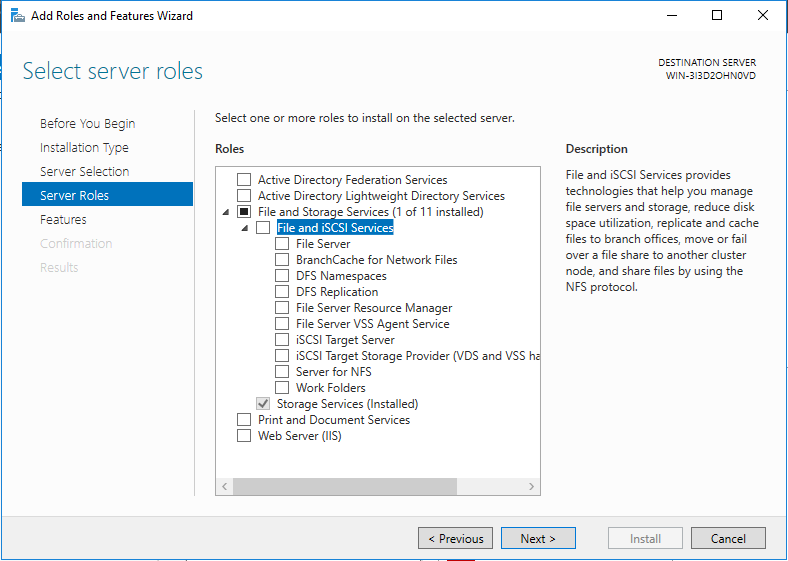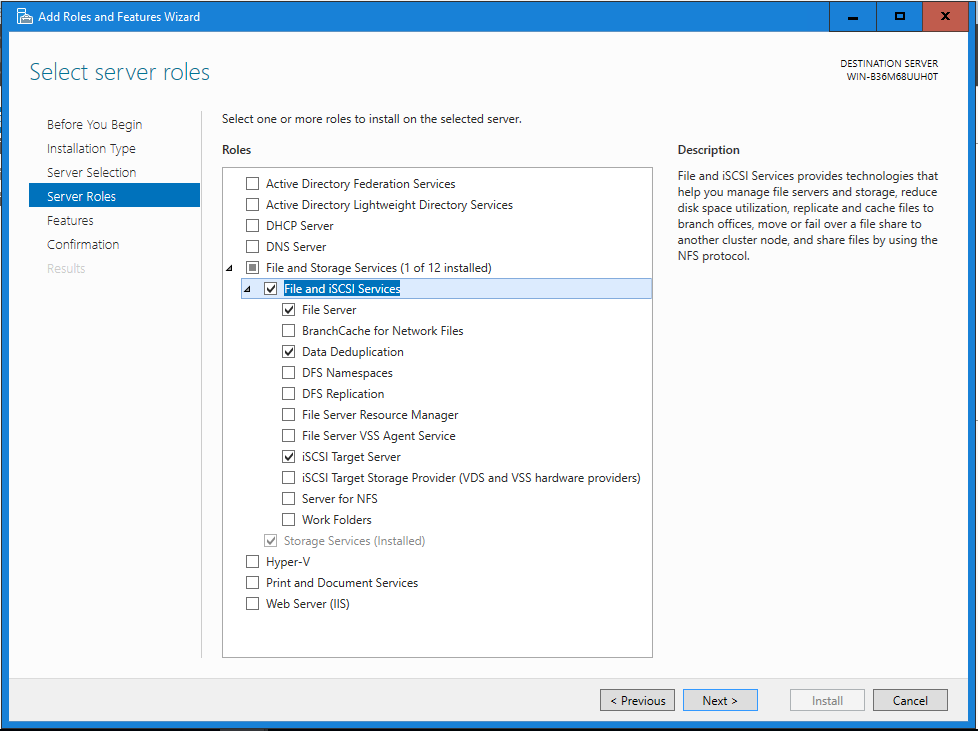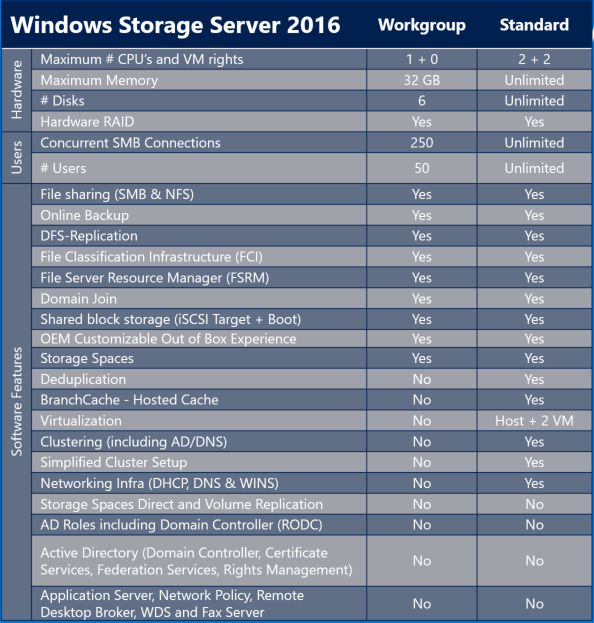Announcing Windows Storage Server 2016
Windows Server 2016 launches to the world this week and this includes new Windows Storage Server 2016 editions. Storage Manufacturers will begin launching Windows Storage Server 2016 Standard edition appliances over the next few quarters and early next year, Windows Storage Server 2016 Workgroup editions will also become available through embedded distribution channels directly from Microsoft or through distributors like B-Square, Avnet and Arrow.
Windows Storage Server 2016 is not directly available for sale to the general public -- it is only available as part of an integrated hardware offering or as an available field upgrade from your hardware manufacturer. Windows Storage Server 2016 fully supports upgrades from previous versions as seen in this handy upgrade and conversion options for Windows Server 2016 article. Windows Storage Server manufacturers and application developers can evaluate the operating system using an MSDN subscription and all Windows Storage Server 2016 features can also be tested using Windows Server 2016 Standard.
Windows NAS has been one of the key pillars of IT infrastructure for decades. One out of five Windows Servers have the File Server role installed and we know that folks absolutely love Server Message Block (SMB) and they use it extensively to share files. Performance and security gains in SMB from Windows Server 2008 R2 to Windows Server 2016, are more than double. New advancements in networking, such as RDMA, have catapulted Ethernet past FibreChannel in performance -- and at a fraction of the deployment and management cost of a Storage Area Network (SAN). Windows Storage Server 2016 delivers rock-solid SMB, NFS and iSCSI storage services easily and efficiently.
11 Noteworthy Windows Storage Server 2016 features:
1. Data Deduplication
Prior to Windows Storage Server 2016, volumes had to be specifically sized for the expected churn, with volume sizes above 10 TB not being good candidates for deduplication. In Windows Storage Server 2016, Data Deduplication supports volume sizes up to 64 TB and supports individual file sizes up to 1TB. A new Usage Type has been defined for Virtualized Backup to quickly and seamlessly deploy data deduplication for Virtualized Backup Applications, like Data Protection Manager.
2. Azure Backup
Azure Backup is our Azure-based service you can use to back up (or protect) and restore your data in the Microsoft cloud. Azure Backup replaces your existing on-premises or off-site backup solution with a cloud-based solution that is reliable, secure, and cost-competitive. Azure Backup does not limit the amount of inbound or outbound data you transfer. Azure Backup also does not charge for the data that is transferred unless you need to transfer a huge amount using the import/Export service. Learn more about Azure Backup here and then setup a new backup vault.
3. Work Folders - immediate sync to Windows 10 clients
In Windows Storage Server 2012 R2, when file changes are synced to the Work Folders server, clients are not notified of the change and wait up to 10 minutes to get the update. When using Windows Storage Server 2016, the Work Folders service immediately notifies Windows 10 clients and the file changes are synced immediately.
4. ReFS – The Resilient File System
Resilient File System (ReFS), introduced with Server 2012, enables VHDX files hosted on ReFS volumes to enjoy very significant performance improvements during provisioning and checkpoint merges.
5. Storage Quality of Service
You can now use storage quality of service (QoS) to centrally monitor end-to-end storage performance and create policies using Hyper-V in Windows Storage Server 2016. Create storage QoS policies and assign them to one or more virtual disks on Hyper-V virtual machines. Storage performance is automatically readjusted to meet policies as the storage load fluctuates.
6. SMB Hardening (SYSVOL and NETLOGON)
In Windows 10 and Windows Server 2016, client connections to the Active Directory Domain Services default SYSVOL and NETLOGON shares on domain controllers now require SMB signing and mutual authentication (such as Kerberos). This change reduces the likelihood of man-in-the-middle attacks.
7. PowerShell 5.1
Windows PowerShell 5.1 includes significant new features, including support for developing with classes and new security features that extend its use, improve its usability, and allow you to control and manage Windows-based environments more easily and comprehensively.
8. NVDIMM support
Windows Server 2016 enables the use of persistent memory devices in the form of NVDIMM-N. NVDIMMs provide a persistent storage medium with near-DRAM speeds and reside on the memory bus, significantly reducing I/O latencies. Through enhancements in NTFS, Windows Server 2016 is able to grant applications direct access (DAX) to the byte-ranges of an NVDIMM and fully unlock the potential of this technology. See these videos about NVDIMM as Block Storage, Byte-Addressable Storage and Health Management capabilities.
9. Time synchronization
Physical and virtual machines benefit from greater time accuracy due to improvements in the Win32 Time and Hyper-V Time Synchronization Services. Windows Server can now host services that are compliant with upcoming regulations which require a 1ms accuracy with regards to UTC.
10. Just Enough Administration
Just Enough Administration (JEA) in Windows Server 2016 is security technology that enables delegated administration for anything that can be managed with Windows PowerShell. Capabilities include support for running under a network identity, connecting over PowerShell Direct, securely copying files to or from JEA endpoints, and configuring the PowerShell console to launch in a JEA context by default.
11. Windows Console (cmd.exe prompt)
The command prompt had some amazing updates for this release. My personal favorite is that you can dynamically resize a cmd.exe window! Checkout all of the quick keyboard commands and tips and tricks that are now available.
Windows Storage Server 2016 has many years of improvements and it delivers a full suite of storage and storage management functionality to keep your files highly-available and safe.
Server roles found in Windows Storage Server 2016 Standard:
Server roles found in Windows Storage Server 2016 Workgroup: 
Workgroup Edition Limits:
• 50 Users and 250 simultaneous SMB Connections:
• 50 users with file and print = 100 SMB sessions.
• 8 node cluster with 4 NICs using SMB multichannel = 128 SMB connections.
• 1 CPU Socket
• 32GB RAM Maximum
• 6 Disks, no external SAS
Premium Features in Standard Edition:
• Deduplication
• Hosted BranchCache
• Clustering
• Virtualization Rights for two VMs
• Network infrastructure for a branch office
Features Not in Windows Storage Server 2016:
• Storage Spaces Direct
• Volume Replication
• Domain Controller, Certificate Services, Federation Services, Rights Management
• Application Server, Network Policy Server, Remote Desktop Services, WDS and Fax Server
Here is a table with the features and limits:
Windows Storage Server 2016 storage solutions will be hitting the market before the end of the year and they are going to have some of the best price to performance ratios available for any storage solution on the market.
Watch this blog for product announcements and links to Windows storage solutions for any size business.
Cheers,
Scott Johnson
Senior Program Manager
Windows Storage Server
@Supersquatchy


